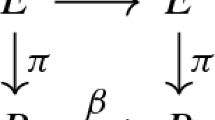Abstract
In this paper a given spacetime theoryT is characterized as the theory of a certainspecies of structure in the sense of Bourbaki [1]. It is then possible to clarify in a rigorous way the concepts ofpassive andactive covariance ofT under the action of the manifold mapping groupG M . For eachT, we define also aninvariance groupG I T and, in general,G I T ≠G M . This group is defined once we realize that, for eachτ ∈ModT, each explicit geometrical object defining the structure can be classified as absolute or dynamical [2]. All spacetime theories possess alsoimplicit geometrical objects that do not appear explicitly in the structure. These implicit objects are not absolute nor dynamical. Among them there are thereference frame fields, i.e., “timelike” vector fieldsX ∈TU,\(U \subseteq M\) M, whereM is a manifold which is part ofST, a substructure for eachτ ∈ModT, called spacetime. We give a physically motivated definition of equivalent reference frames and introduce the concept of theequivalence group of a class of reference frames of kind X according to T, G X T. We define thatT admits aweak principle of relativity (WPR) only ifG X T ≠ identity for someX. IfG X T =G I T for someX, we say thatT admits a strong principle of relativity (PR).
The results of this paper generalize and clarify several results obtained by Anderson [2], Scheibe [3], Hiskes [4], Recami and Rodrigues [5], Friedman [6], Fock [7], and Scanavini [8]. Among the novelties here, there is the realization that the definitions ofG I T andG X T can be given only when certain boundary conditions for the equations of motion ofT can be physically realizable in the domainU \(U \subseteq M\) M, where a given reference frame is defined. The existence ofphysically realizable boundary conditions for eachτ ∈ModT (in ∂U), in contrast with the mathematically possible boundary condition, is then seen to be essential for the validity of a principle of relativity forT.
The methodology of the present paper has been applied to several topics of spacetime physics with very interesting results. Here we mention:
-
(i)
The Newtonian concepts of absolute space and absolute time can be presented in a very elegant way as “species of structure”. One of the surprising results is that we succeeded in finding a Lorentzian structure [9] in Newtonian spacetime without introducing any new explict geometrical object in the original structure. The Newtonian spacetime structure and its relation to the relativistic spacetime structure and to the structure of the spacetime of the so-called Lorentz aether theories [11,12] is fully discussed in [13].
-
(ii)
It is possible to present in a novel and unified way the question concerning experiments designed to detect a possible breakdown of Lorentz invariance, a subject we already dedicated attention to in Rodrigues and Tiomno [11,12] and Rodrigues [14,15]. A full account of this subject will be published elsewhere.
-
(iii)
In Rodrigues and Scanavini [16], we proved that there are models of General Relativity that contain a canonical privileged locally inertial reference frame that can be physically distinguished from any other frame by experiments doneinside the frame.
Although the formalism of this paper may at first sight look very abstract, actually it is easy to aplly it to specific theories. We present an example at the end of the paper which is sufficiently general to show “in action” almost all concepts introduced in this paper.
Similar content being viewed by others
References
Bourbaki, N., 1957,Theorie des Ensembles, Chap. 4, Herman, Paris.
Anderson, J. L., 1967,Principles of Relativity Physics, Academic Press, New York.
Scheibe, E., 1978, in Niinilvolto and Tuomela E. (eds.), “The logic and epistemology of scientific change”,Acta Phil. Fenn. XXX, 205 - 332.
Hiskes, A. L. D., 1984,Found. Phys. 14, 307 - 332.
Recami, E., and Rodrigues, W. A., Jr., 1982,Found. of Physics. 12, 709 - 718.
Friedman, M., 1983,Foundations of Space-Time Theories, Princeton University Press, Princeton.
Fock, V., 1958,Space, Time and Gravitation, Pergamon Press, New York.
Scanavini, M. E. F., 1986, Ph.D thesis IMECC-UNICAMP.
Rodrigues, W. A., Jr., and Faria-Rosa, M. A., 1989,Found. Phys. 19, 705–724.
Rodrigues, W.A. Jr. and Oliveira, E.C.,Phys. Lett. A14, 474–484 (1989)
Rodrigues, W. A., Jr., and Tiomno, J., 1984,Rev. Bras. Fisica 14 (Suppl.), 450 - 565.
Rodrigues, W. A., Jr., and Tiomno, J., 1985,Found. Phys. 15, 955 -961.
Rodrigues, W. A., Jr., and Q.A.G. de Souza, “The structures of Newtonian, Lorentz aether and relativistic spacetimes RT/IMECC-UNICAMP, to be published.
Rodrigues, W. A. Jr., 1983,Nuovo Cimento B74, 199 - 211.
Rodrigues, W. A., Jr., 1984,Hadronic Journal 7, 436 -455.
Rodrigues, W. A., Jr., and Scanavini, M. E. F., 1989, Privileged reference frames in general relativity, R.T. 07/89, IMECC-UNICAMP, subm.Found. Phys. Lett.
Reinchenbach, H., 1958,The Philosophy of Space and Time, Dover, New York.
Trautman, A., 1984,Differential Geometry for Physicists, Bibliopolis, Napoli.
Bishop, R. L., and Goldberg, S. I., 1980,Tensor Analysis on Manifolds, Dover, New York.
Veblen O. and J.H.C. Whitehead, 1932,Foundations of Differential Geometry, Cambridge Univ. Press.
Einstein, A., “On the electrodynamics of moving bodies”, in A. Sommerfeld, (Leipzig),The Principle of Relativity, Dover (1952);Ann. der Physik. 17 (1905).
Faria-Rosa, M.A., E. Recami, and W. A. Rodrigues, Jr., 1986,Phys. Lett. B173, 233–236; 1987,B188, 511E.
Rodrigues, W.A., Jr., E. Recami, A. Maia, Jr., and M. A. Faria-Rosa, 1989,Phys. Lett. B220, 195–199.
S. Marinov, S., 1974,Czech. J. Phys. B24, 965 (1980); Gen. Rel. Grav.12, 57.
Sherwin, C.W., 1987,Phys. Rev. A35, 365; 1989 in M.C. Duffy (ed.),Physical Interpretations of Relativity Theory, vol. II, pp. 59-61, British Soc. Phil. Science, London.
Cavalleri, G., 1989, in M.C. Duffy (ed.),Physical Interpretations of Relativity Theory, Vol. II, pp. 1–23, Britsh Soc. Phil. Science, London.
Cavalleri G. and G. Spavieri, 1989,Il Nuovo Cimento A101, 213–223.
Author information
Authors and Affiliations
Rights and permissions
About this article
Cite this article
Rodrigues, W.A., Scanavini, M.E.F. & de Alcantara, L.P. Formal structures, the concepts of covariance, invariance, equivalent reference frames, and the principle Relativity. Found Phys Lett 3, 59–79 (1990). https://doi.org/10.1007/BF00666085
Received:
Revised:
Issue Date:
DOI: https://doi.org/10.1007/BF00666085



